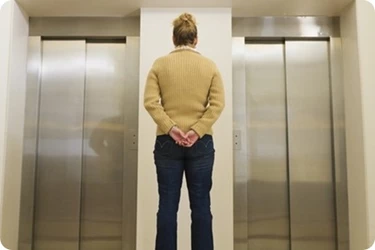 Here comes another section in the anxiety disorders chapter of DSM-5. It's agoraphobia. (Memorization clue: Agora is Greek for a public open space. Fear of that, more or less.) Agoraphobia is a new dx in DSM-5. Criteria look like this:
Here comes another section in the anxiety disorders chapter of DSM-5. It's agoraphobia. (Memorization clue: Agora is Greek for a public open space. Fear of that, more or less.) Agoraphobia is a new dx in DSM-5. Criteria look like this:
A. Marked fear or anxiety about two or more of these:
1. Public transportation
2. Open spaces (e.g., parking lots, bridges)
3. Enclosed places (e.g., shops, theaters)
4. Standing in line or being in a crowd
5. Being outside of the home alone
B. These situations are feared or avoided due to thoughts of being unable to escape when and if panic-like symptoms (or other incapacitating or embarrassing symptoms) develop.
C. These situations almost always provoke fear/anxiety.
D. These situations are actively avoided, require the presence of a companion, or are endured with intense fear/anxiety.
E. Reaction is out of proportion to actual danger.
F. Symptoms present for 6 months or more
G. Symptoms cause clinically significant distress
H. If another medical condition (e.g., IBS) is present, fear/anxiety/avoidance are clearly excessive.
I. Symptoms not better explained by another disorder.
The list of other disorders that agoraphobia might be better explained by is useful, especially for narrowing down answers on the ASWB exam. On that list: specific phobia, social anxiety disorder, OCD, body dysmorphic disorder, PTSD, and separation anxiety disorder.
The most difficult distinctions there may be the first two. Imagine a question like this:
A client tells a social worker she hates leaving her apartment on her own. She says she's terrified of having a panic attack and not being able to escape from wherever she is when it hits. "I had to quit my job because the elevators in the building freaked me out so much," she says. She hasn't worked in over six months. What is the MOST likely diagnosis for this client?
A. Specific Phobia, Situational
B. Social Anxiety Disorder
C. Panic Disorder with Agoraphobia
D. Agoraphobia
You know the answer because it's the subject of the blog post. But on a test, without that giant clue, do you think you might've been tempted by the other possibilities? Specific phobia doesn't really fit. The client's anxiety is situational, but the situation isn't just elevator or just shopping--it's more widespread. She's afraid to leave the apartment. Social anxiety isn't a great fit either--it's places and her own panic the client seems to fear, not other people and their judgment. How about panic disorder with agoraphobia? The client may meet criteria for panic disorder--she reports recurrent, unpredictable panic attacks. But there's this: panic disorder with agoraphobia is a DSM-IV-TR diagnosis. It doesn't appear in DSM-5. DSM-5 separates panic disorder and agoraphobia; clients can be diagnosed with either or both. So, narrowed down thusly, you have your answer: D) Agoraphobia.
If this comes up on the exam, consider yourself ready for it.
To read up on agoraphobia, try:
Now that you're prepped for an agoraphobia-related question on the big test, get more practice on the topic and others by signing up with SWTP.
Good luck on the exam!

 Here comes another section in the anxiety disorders chapter of DSM-5. It's agoraphobia. (Memorization clue: Agora is Greek for a public open space. Fear of that, more or less.) Agoraphobia is a new dx in DSM-5. Criteria look like this:
Here comes another section in the anxiety disorders chapter of DSM-5. It's agoraphobia. (Memorization clue: Agora is Greek for a public open space. Fear of that, more or less.) Agoraphobia is a new dx in DSM-5. Criteria look like this: